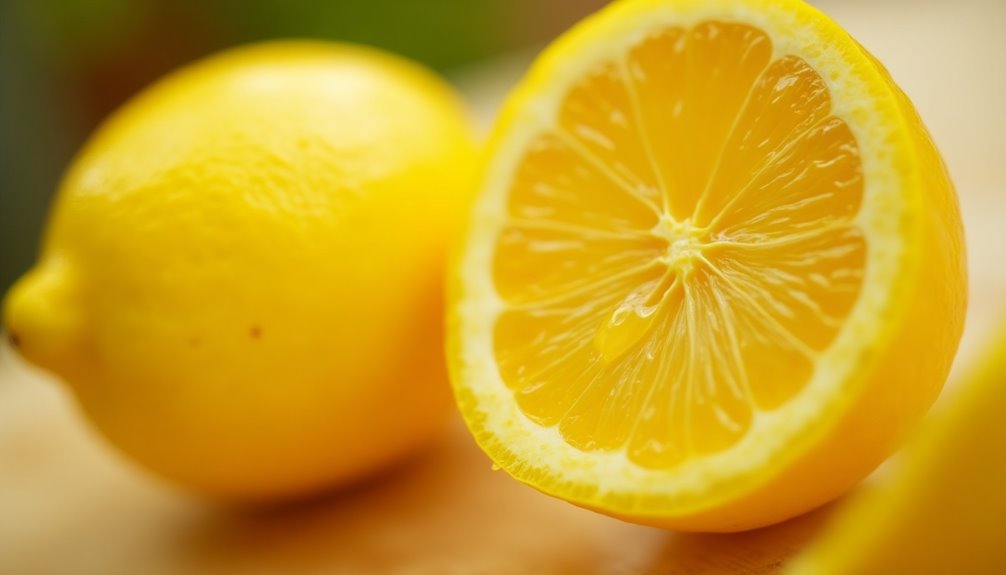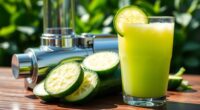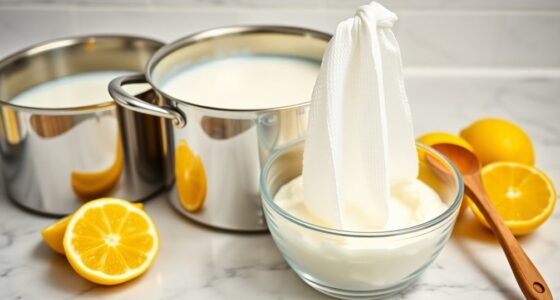A medium lemon usually gives you about 3 tablespoons, or 1.5 ounces, of juice. Keep in mind that the actual yield can vary based on the lemon's ripeness, size, and type. Some juicier lemons might offer up to 4 tablespoons. If you're planning a recipe, it's smart to have a couple of extra lemons on hand just in case. You'll find other useful tips for maximizing juice yield and measuring accurately if you stick around.
Key Takeaways
- A medium lemon typically yields about 3 tablespoons (1.5 ounces) of juice on average.
- Juice yield can vary based on the lemon's ripeness, size, and variety.
- Some plump lemons can produce up to 4 tablespoons of juice.
- Half a medium lemon yields approximately 1½ tablespoons of juice.
- Rolling the lemon before juicing can help maximize juice extraction.

When you're squeezing a medium lemon, you can expect to get about 3 tablespoons of juice, or roughly 1.5 ounces. This juice yield is typical for a medium-sized lemon, but remember that the actual amount can vary depending on the lemon's ripeness, size, and variety. In some cases, you might find that a particularly plump lemon yields as much as 4 tablespoons of juice.
So, if you're planning a recipe that requires lemon juice, knowing how much juice you can get from one lemon is essential.
If you're wondering about how much juice is in one lemon, it's helpful to consider that half a medium lemon usually produces around 1½ tablespoons of juice. This means if you need a specific amount, you can easily calculate how many lemons to buy. For example, if a recipe requires ½ cup of lemon juice, you'd typically need about 3 medium lemons. This calculation can save you from overestimating, which could lead to excess juice that you mightn't use.
Before you cut into that lemon, there's a little trick to maximize your juice yield. Rolling the lemon on a countertop can help break down the internal structure of the fruit, releasing more juice. This simple step can make a noticeable difference, especially if you're squeezing multiple lemons for a larger batch of lemonade or a zesty dressing.
By rolling the lemon, you're ensuring that you get every drop possible from the fruit.
When you're in the kitchen, it's always a good idea to measure your juice yield accurately, especially when preparing recipes requiring lemon juice. Lemon juice can add a bright acidity to dishes, enhancing flavors in everything from marinades to desserts. If you're unsure about how much juice you'll need, it's better to have an extra lemon on hand, just in case.
After all, you wouldn't want to start a recipe only to find that you're short on that tangy ingredient.
Another factor to consider is that not all lemons are created equal. Some may be juicier than others, which is why it's beneficial to have a few extra lemons just in case.
Frequently Asked Questions
How Much Lemon Juice Is in a Medium Lemon?
When you're squeezing a medium lemon, you can expect to get about 3 tablespoons of juice.
Depending on its size and ripeness, it might yield anywhere from 2 to 4 tablespoons.
If you need more juice for a recipe, keep in mind that half a medium lemon produces around 1½ tablespoons.
Using fresh lemon juice really enhances your dish, so always reach for a fresh lemon when you can!
Can You Substitute Bottled Lemon Juice for Fresh Lemon Juice?
Sure, you can substitute bottled lemon juice for fresh, but don't be surprised if your dish doesn't taste quite as zesty.
While it's convenient, bottled juice often lacks the bright flavor and nutrients of fresh juice.
If you're in a pinch, use about 2 tablespoons of bottled juice for every medium lemon.
Just remember, you're trading freshness for convenience, and your taste buds might notice that difference!
How Much of Bottled Lemon Juice Is Equal to 1 Lemon?
When you need to substitute bottled lemon juice for fresh lemon juice, remember that 2 tablespoons of bottled juice typically equals the juice of one medium lemon.
If a recipe calls for multiple lemons, you can use about 1/2 cup of bottled lemon juice to replace the juice of three medium lemons.
Just keep in mind that bottled juice might taste a bit different due to processing, so adjust your recipe as needed!
Is 2 Lemons a Day Too Much?
Is two lemons a day too much for you? Generally, it's not. Consuming two medium lemons can actually provide a good dose of vitamin C, hydration, and antioxidants while keeping calorie intake low.
Just remember, if you notice any sensitivity to acidity, adjust your intake accordingly. Moderation is key to reaping the benefits without risking dental erosion or digestive discomfort.
Listen to your body, and enjoy the zest lemons bring to your diet!
Conclusion
In summary, a medium lemon typically yields about 2 to 3 tablespoons of juice. So next time you’re whipping up a dish or cocktail, remember this simple fact—it’s like finding Wi-Fi in the middle of nowhere; it can really elevate your experience. Just squeeze that lemon, and let its bright flavor shine through. A little zest can turn the ordinary into the extraordinary, proving that even the simplest ingredients can make a lasting impact. When you’re unsure about how much juice from a lemon you need for your recipe, just grab a medium lemon and you should be in good shape. Experimenting with the right amount can enhance your dish’s flavor profile, allowing the acidity to balance other ingredients perfectly. Remember, a little goes a long way, so it’s always best to start with less and adjust to your taste.
Cindy thoroughly researches juicing trends, techniques, and recipes to provide readers with practical advice and inspiration. Her writing style is accessible, engaging, and designed to make complex concepts easy to understand. Cindy’s dedication to promoting the advantages of juicing shines through her work, empowering readers to make positive changes in their lives through the simple act of juicing.

















